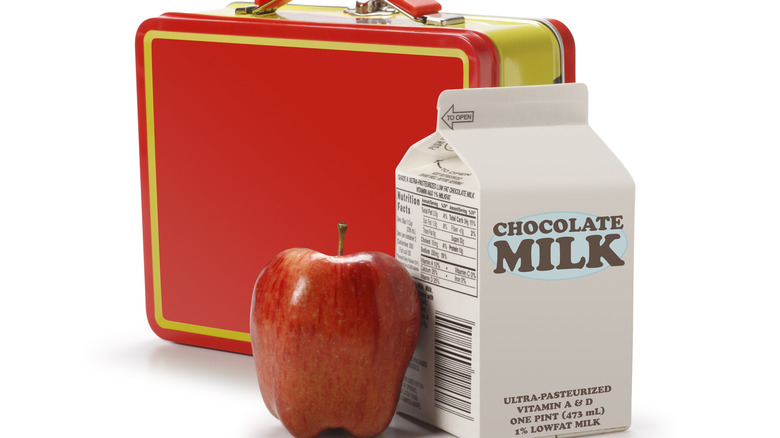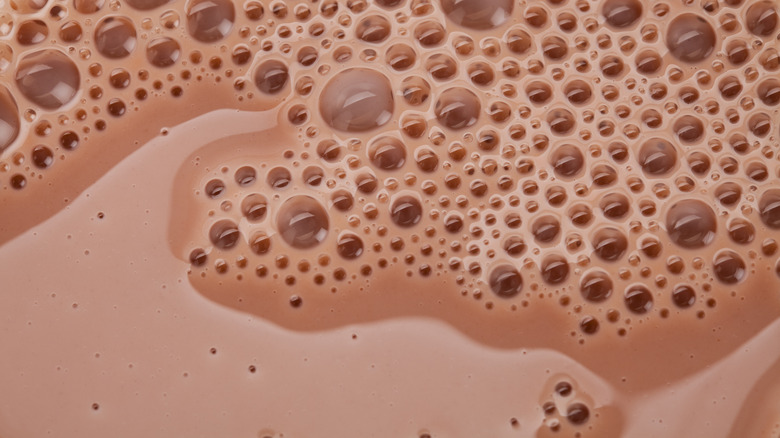Why Nutritionists Can't Get Rid Of Chocolate Milk In Schools
You remember what it's like to be a kid in school: The bell rings. You rush out of your classroom, make your way to the cafeteria, and ask the lunch lady for a slice of cheese pizza and an apple. As you wait to pay, you notice a giant poster of a teen pop star with a white mustache painted above their lip. The text reads, "Got milk?"
This nostalgic ad campaign poses the question that's been on everyone's milk-mustache-lips for almost two decades now, from the dairy industry to health experts to Congress. Should milk be served in schools? Should it be whole or nonfat? Most importantly, what about chocolate milk? This sweetened dairy product has been a welcome addition to children's meals at home for decades, yet when discussing whether or not it belongs in schools, there have been opposing viewpoints.
In general, nutritionists who support the removal of chocolate milk from schools, such as officials from the American Heart Association (AHA), are concerned about the link between sugar content and childhood obesity. However, supporters of the brown beverage, such as lobbyists for the milk industry, note concerns about children's overall milk consumption, nutrition for students (especially those who are low-income), and food waste. Yet, because decisions about what schools serve in their cafeterias aren't made by health experts but rather by Congress, chocolate milk stays.
The history and future of milk in schools
The first time half-pints of milk showed up in schools was in 1914 in Florida, where students were served the beverage daily. The National School Lunch Program was created in 1946, but milk wasn't added until 1966 when the United States Department of Agriculture (USDA) took it over. Since then, a variety of milk became available to students: whole, 2%, skim, chocolate, and even strawberry. In 2006, however, a wellness policy was instated for all schools participating in federally-supported school meal programs, calling for a re-evaluation of nutrition guidelines. At this time, more progressive districts, such as those in Berkeley, California, completely removed chocolate milk from schools and served only organic, low-fat white milk.
While school district officials were allowed to make their own decisions regarding the types of milk served at a local level, the issue became a federal one in 2012 when the Obama administration required flavored milk served in schools to be fat-free. In 2018, the Trump administration reversed this rule, allowing low-fat flavored options back in cafeterias. More recently, in 2023, there was talk that the USDA may ban chocolate milk in middle and elementary schools in an attempt to help children develop healthy eating habits at a young age. In April 2024, however, the USDA decided that chocolate milk will remain in middle and elementary school cafeterias, although there will be a limit on its added sugars.
Is chocolate milk nutritious or not?
With all of these back-and-forth rules and regulations over the past 18 years, chocolate milk has been the center of attention, garnering one important question. No, not "does chocolate milk come from brown cows?", but is chocolate milk nutritious or not? It all depends on how you look at it.
Those who support keeping chocolate milk on cafeteria menus, such as the National Dairy Council, argue that it provides the same nutrition as white milk, with vitamin D and calcium, while catering to children's taste. Without the choice of chocolate, kids might pass on milk completely and not get any of its nutritious value, which is especially troubling for low-income students who count on school meals. While supporters recognize that it contains 60 more calories than white milk, they argue that it's not as unhealthy as many of the sugary drink alternatives, such as soda.
Some nutritionists, such as those from the AHA, on the other hand, oppose these arguments. They say adding sugar (24 grams per cup) to milk isn't healthy, and if we want kids to drink milk, it should be white. Plus, dairy alternatives are expected to spike in popularity due to the growing understanding of their health benefits. As always, there is a middleman, like the American Academy of Pediatrics, that recognizes the benefits of kids drinking milk as well as the progress being made to cut back on the amount of sugar in chocolate milk.


